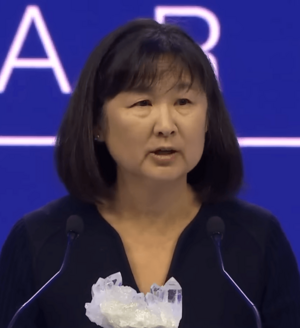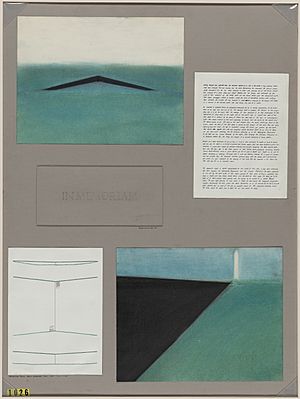Maya Lin facts for kids
Quick facts for kids
Maya Lin
|
|
|---|---|

Lin (2023; age 63)
|
|
| Born |
Maya Ying Lin
October 5, 1959 Athens, Ohio, U.S.
|
| Nationality | American |
| Education | Yale University (BA, MArch) |
| Known for | Land art, architecture, memorials |
|
Notable work
|
Vietnam Veterans Memorial (1982) Civil Rights Memorial (1989) |
| Spouse(s) |
Daniel Wolf
(m. 1985; died 2021) |
| Awards | National Medal of Arts Presidential Medal of Freedom |
| Maya Lin | |||||||
|---|---|---|---|---|---|---|---|
| Traditional Chinese | 林瓔 | ||||||
| Simplified Chinese | 林璎 | ||||||
|
|||||||
Maya Lin (born October 5, 1959) is a famous American architect, designer, and sculptor. She is known for creating important memorials and beautiful art. Maya Lin was born in Athens, Ohio. Her parents came from China. She studied architecture at Yale University.
Maya Lin became well-known in 1981. She was still a student when she won a national contest. This contest was to design the Vietnam Veterans Memorial in Washington, D.C.. Her design was simple and powerful. It became very famous and important.
Since then, Lin has designed many different projects. These include memorials, buildings, landscapes, and sculptures. In 1989, she designed the Civil Rights Memorial in Montgomery, Alabama.
Even though she is famous for memorials, Maya Lin also creates art about the environment. She often shows how nature is changing. Lin says she gets ideas from nature's beauty. She also finds ideas in Japanese gardens and Native American earth mounds.
Contents
Who is Maya Lin and where did she grow up?
Maya Lin was born in Athens, Ohio. Her parents moved to the United States from China in the late 1940s. Her father, Henry Huan Lin, was a ceramist and a dean at Ohio University. Her mother, Julia Chang Lin, was a poet and a professor at the same university.
Maya Lin has said that she didn't realize she was Chinese until she was older. She became interested in her family's background in her thirties.
Growing up, Lin spent a lot of time studying. She loved school. While in high school, she took classes at Ohio University. There, she learned how to cast bronze. She finished high school in 1977. Then, she went to Yale University. She earned her first degree in 1981 and a master's degree in architecture in 1986.
Why is the environment important to Maya Lin?
Maya Lin has cared about the environment since she was young. At Yale University, she spent a lot of time working on environmental issues. She believes her interest in nature came from growing up in rural Ohio. Nearby ancient Native American burial mounds, like those of the Hopewell tradition, inspired her.
Lin's work often explores how people connect with their surroundings. She creates earthworks, sculptures, and art installations. She once said, "I'm very much a product of the growing awareness about ecology and the environmental movement." She tries to find a balance in the landscape. She respects nature and does not try to control it. Even the Vietnam Veterans Memorial is like an earthwork.
Her art often shows "hidden histories" of landscapes. It helps people see places they might not notice. Lin's work highlights how humans affect the environment. She brings attention to issues like global warming, endangered water bodies, and animal extinction. Her recent memorial, What Is Missing?, explores these topics.
Maya Lin tries to make her art with minimal impact on nature. She uses recycled and sustainable materials. She also tries to reduce carbon emissions. She avoids harming the places where she works. Lin has also served on the board of trustees for the Natural Resources Defense Council. This group works to protect nature.
What is the Vietnam Veterans Memorial?

In 1981, when Maya Lin was only 21, she won a contest to design the Vietnam Veterans Memorial. This memorial was built on the National Mall in Washington D.C. Her design was chosen from 1,422 entries.
Her design featured a black granite wall. It had the names of 57,939 soldiers carved into it. Hundreds more names have been added since. The wall is shaped like a "V." One side points to the Lincoln Memorial, and the other points to the Washington Monument. The memorial was designed in a minimalist style. This was different from older war memorials. It was finished in October 1982 and opened in November 1982.
Lin wanted the memorial to be like an opening in the earth. She said it would symbolize the pain of the war. She imagined cutting into the earth. Over time, that pain would heal.
At first, Lin's design caused some debate. Some people didn't like its simple style. Others worried about her young age or her Asian background. Some didn't like the dark color of the granite. They felt it showed a negative view of the war. Lin defended her design to the US Congress. A compromise was made. A bronze statue called Three Soldiers and an American flag were placed near Lin's design.
Despite the early debate, the memorial has become a very important place. Many people visit it. Family and friends of soldiers leave personal items there. In 2007, a poll ranked it among America's Favorite Architecture. It is now one of the most visited sites in Washington D.C. It also honors veterans from the Afghanistan and Iraq wars.
Lin once said that if the contest had not been "blind," she might not have won. This means if her name was known, her ethnicity might have stopped her. She was even called names after her background was revealed.
What other works has Maya Lin created?

Lin's The Women's Table in front of the Sterling Memorial Library, commemorating the role of women at Yale University.
|
Maya Lin has her own studio in New York City. She has designed many projects since the Vietnam Veterans Memorial. These include the Civil Rights Memorial in Montgomery, Alabama (1989). She also created the Wave Field outdoor art at the University of Michigan (1995).
Notable Projects
- Peace-Chapel (1989): An open-air chapel at Juniata College. It connects peace, art, nature, and spirituality. It has a circle of stones for seats and the sky for a ceiling.
- Wave Field (1995): At the University of Michigan. Lin was inspired by ocean waves. She wanted to capture the movement of water in the earth. This was her first earthwork.
- Confluence Project (2000): A series of outdoor art pieces. They are located at historical spots along the Columbia River and Snake River in Washington and Oregon.
- Eleven Minute Line (2004): An earthwork in Sweden. Lin was inspired by Native American burial mounds in Ohio. It is a path that takes about eleven minutes to walk.
- Waterline (2006): Made of aluminum tubing and paint. It shows the Mid-Atlantic ridge, an underwater mountain range. Viewers can walk on it.
- Bodies of Water series (2006): Sculptures of three endangered bodies of water. They are made of layered birch plywood. Lin wanted to show "unseen ecosystems" that people pollute.
- Input (2004): A landscape design at Ohio University. It looks like a computer punch card. Lin studied computer programming there in high school.
- Above and Below (2007): An outdoor sculpture at the Indianapolis Museum of Art. It is made of colored aluminum tubing.
- 2 × 4 Landscape (2008): A large sculpture made of many pieces of wood. It looks like moving water. Lin wanted to bring the feeling of her Wavefield earthwork indoors.
- Wave Field (2008): At the Storm King Art Center in New York. It is a larger version of her earlier Wave Field. It covers four acres of land.
- Museum of Chinese in America (2009): Lin designed a building for this museum in New York City. This project was very personal to her. She wanted her daughters to know their heritage.
- Silver River (2009): Her first art piece in Las Vegas Strip. It is an 84-foot cast of the Colorado River. It is made of reclaimed silver. Lin wanted to highlight water conservation.
- Pin River - Sandy (2013): Created after Hurricane Sandy. It shows the flood zone of the hurricane. Lin wanted to raise awareness about how natural oyster beds used to protect New York City.
- A Fold in the Field (2013): Her largest work. It is a huge earthwork in New Zealand.
- What is Missing? (2009-present): Lin calls this her "final memorial." It focuses on the loss of plants and animals on Earth. It uses sound, media, and art to raise awareness. It exists in many forms and places.
- Neilson Library (2015-2021): Lin worked on redesigning this library at Smith College.
Awards and Recognition
On February 25, 2010, the Obama administration gave Maya Lin the 2009 National Medal of Arts. In 2016, she also received the Presidential Medal of Freedom. This is one of the highest honors a civilian can receive in the U.S.
When she won, Lin said her "last memorial" was What Is Missing?. She wanted to focus on something she cared about since childhood. She also spoke about her concerns for climate change and the loss of species.
In 2022, the Smithsonian's National Portrait Gallery opened an exhibition about Maya Lin. It showed her work as an architect, sculptor, and environmentalist.
How does Maya Lin design her art?
Maya Lin calls herself a "designer" more than an "architect." She focuses on how spaces will be used in the future. She thinks about the balance between nature and people. She wants to create feelings and symbols in her designs. She believes spaces should connect smoothly from inside to outside. This has led to her memorable designs.
Lin believes art should be new and surprising. She says her work helps people notice their surroundings. This includes both the physical world and their feelings. When she starts a project, she first thinks about it verbally. She tries to understand its ideas and meanings. She believes gathering information is very important in architecture.
After understanding the project's purpose, Lin makes many models. In her memorials, like the Vietnam Veterans Memorial, she often shows things in order of time. This is also seen in her art about the changing environment. Lin also likes to combine different materials and ideas. She feels she exists "between science and art, art and architecture, public and private, east and west." She tries to find a balance between these different forces.
Personal Life
Maya Lin was married to Daniel Wolf, a photography dealer, until he passed away in 2021. She has two daughters, India and Rachel. She lives in New York and Colorado. Her older brother, Tan Lin, is a poet.
Awards and Honors
Maya Lin has received many awards and honors:
- 1999: Rome Prize
- 2000: Golden Plate Award from the American Academy of Achievement
- 2003: Finn Juhl Prize
- 2005: Elected to The American Academy of Arts and Letters
- 2005: Elected to National Women's Hall of Fame
- 2007: AIA Twenty-five Year Award
- 2009: National Medal of Arts
- 2011: Thomas Jefferson Medal in Architecture
- 2014: The Dorothy and Lillian Gish Prize
- 2016: Presidential Medal of Freedom
- 2024: Received honorary degrees from University of Pennsylvania and Johns Hopkins University
See also
 In Spanish: Maya Lin para niños
In Spanish: Maya Lin para niños


